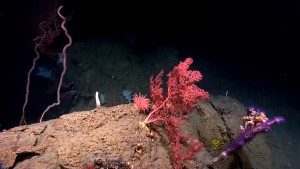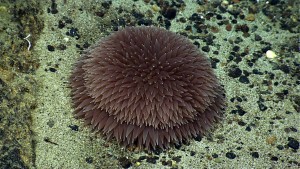
NOAA Ship Okeanos Explorer berthed at the NOAA Ford Island facility located in the middle of Pearl Harbor, Hawaii. Image courtesy of NOAA Office of Ocean Exploration and Research.
In spring, the naturalist’s mind turns to bird watching, wildflower exploration, and other outdoor pursuits. The importance of observation cannot be underestimated: it is by watching and listening that we begin to make connections about the players and processes of the natural world.
This week marked the end of a voyage by the Okeanos Explorer, a research vessel owned and operated by the National Oceanographic and Atmospheric Administration (NOAA). Although the Okeanos Explorer does not collect specimens, its high-quality images, videos, and maps provide a glimpse into the biology and ecology of organisms that are often known only from museum specimens.
The videos and images from Okeanos Explorer are the eyes and ears of deep sea biologists, giving us vital information about where organisms live, how communities are structured, what organisms look like in life, and how organisms move and interact with one another.

Close up image of a glass sponge, with commensal anemones growing through its body. The anemones are as yet un-described members of the family Edwardsiidae. Image courtesy of the NOAA Office of Ocean Exploration and Research, 2015 Hohonu Moana.
My research focus is sea anemones. Footage from Okeanos Explorer shows that these are more abundant in deep sea communities than we might expect, given the number of specimens held by museums. In shallow habitats, sea anemones are important primary producers because they (like their relatives the stony corals) often harbor photosynthetic microorganisms.
Absent light in the deep sea, the biological role of sea anemones is less clear, but footage from Okeanos Explorer shows them crowding the branches of deep-sea sea fans, clinging to rocks, living in the bodies and skeletons of other animals, and dwelling in soft mud.

Benthic cnidarians are common in deep-sea canyons and seamounts. Here, octocorals, cup corals, and anemones share a rock at 1,459 meters depth in Hendrickson Canyon. Image courtesy of NOAA Okeanos Explorer Program, Our Deepwater Backyard: Exploring Atlantic Canyons and Seamounts.
The Okeanos Explorer videos of anemones show subtle variation in color among specimens belonging to the same species. These kinds of insights are invaluable in filling in the blanks for animals otherwise known only from isolated, often damaged specimens. To learn more about the Okeanos Explorer and the habitats it surveys, go to http://oceanexplorer.noaa.gov/okeanos/welcome.html

This image of a pompom anemone is a very helpful complement to our understanding of this species. The tentacles have small muscles at their base and are often shed when the animal is disturbed, so most museum specimens have no or very few tentacles. Image courtesy of NOAA Okeanos Explorer Program, Our Deepwater Backyard: Exploring Atlantic Canyons and Seamounts 2014.
About the Author: Dr. Marymegan Daly is an Associate Professor in the Department of Evolution, Ecology and Organismal Biology and Director of the OSU Fish Division.